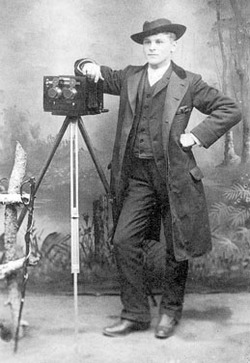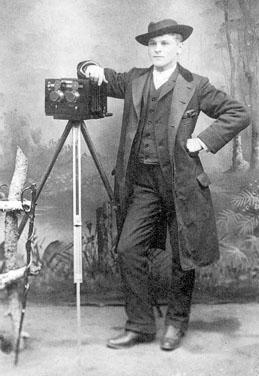Among the Rosebud Sioux
By Lou Hunsinger, Jr.
Williamsport and Lycoming County has been the home to many very talented artists and photographers. One of the most talented, accomplished and least known of these was John Alvin Anderson.
According to Claes H. Jacobson, author of "Rosebud Sioux: A Lakota People in Transition," Anderson during his life was an artist, a mechanic, businessman, mason, musician, art collector, museum curator and most notably, a skilled photographer.
Anderson was born in the rural parish of Vinland-Halland, Sweden on March 25, 1869. †He was the youngest of seven children. His family immigrated to Dents Run in Elk County, Pennsylvania in May 1870, not long after that moved to and lived in Williamsport for a time.
In 1883 he, his father and three brothers went west to the area near the present day Valentine, Nebraska.
Anderson and his family decided to build a homestead there in Cherry County, the largest county in Nebraska, an area populated with many Scandinavian immigrants like themselves. He did odd jobs and carpentry to earn extra money.
By 1885 he had earned enough money to buy his first camera, a Primo 8 x 10-view camera with a revolving back.
Not long after this, Anderson became a photographic apprentice to W.R. Cross, who had several photo studios in towns in northern Nebraska. Cross opened a studio in the area Fort Niobrara and Anderson started taking photos of soldiers at the fort.
In spring of 1889 he attended and was the official photographer of the negotiations that were a part of the Great Council held by General George Crook and the Indians on the Rosebud Sioux Reservation. The negotiations were part of an effort by the U.S. Government to persuade the Lakota Sioux tribes to sell some of their land on portions of the Great Sioux Reservation for use as a white settlement.
At the end of 1889 Anderson returned to Williamsport and attended the Potts Commercial College and also took a job in a commercial photography studio here. During this time he worked in a photo studio with his friend, Charles Schempp.
He returned to the west in 1893, going to Rosebud, South Dakota
In the next several years Anderson extensively photographed the Rosebud Sioux Indians who lived in that area of Nebraska and nearby South Dakota. He did much of this photography for the Army. He also worked in the trading post of his friend, Charles Jordan. He soon became the post's manager and later purchased an interest in the trading post.
In 1895 he married Myrtle Miller of Williamsport and they moved onto the Rosebud Reservation.
During Anderson's time in photographing the Rosebud Sioux he gained an excellent reputation and rapport among the Sioux, which provided him the access for him to produce some of his most memorable photographic images of them.
It was during the 20-year period, 1895 to 1915 that saw Anderson's most significant photographic work among the Rosebud Sioux. Some his photographs contain the only know images of several of the Rosebud chiefs and important families and thereby are a precious historical resource.
In 1936 John and Myrtle Anderson moved to Rapid City, South Dakota, where John became manager of Sioux Indian Museum for three years. Later the Andersons moved to Atscadero, California, where John died on June 26, 1948. Myrtle died in 1961 and both are now in their eternal rest in the Salladsburg Cemetery.
John Anderson left behind a priceless photographic legacy that has helped to preserve the vanishing culture of the Rosebud Sioux. Anderson's photographs of the Rosebud Sioux are displayed in places of honor at places such as the Nebraska Historical Society and at the museum on the Rosebud Sioux Reservation itself.
Among the Rosebud Sioux
By Lou Hunsinger, Jr.
Williamsport and Lycoming County has been the home to many very talented artists and photographers. One of the most talented, accomplished and least known of these was John Alvin Anderson.
According to Claes H. Jacobson, author of "Rosebud Sioux: A Lakota People in Transition," Anderson during his life was an artist, a mechanic, businessman, mason, musician, art collector, museum curator and most notably, a skilled photographer.
Anderson was born in the rural parish of Vinland-Halland, Sweden on March 25, 1869. †He was the youngest of seven children. His family immigrated to Dents Run in Elk County, Pennsylvania in May 1870, not long after that moved to and lived in Williamsport for a time.
In 1883 he, his father and three brothers went west to the area near the present day Valentine, Nebraska.
Anderson and his family decided to build a homestead there in Cherry County, the largest county in Nebraska, an area populated with many Scandinavian immigrants like themselves. He did odd jobs and carpentry to earn extra money.
By 1885 he had earned enough money to buy his first camera, a Primo 8 x 10-view camera with a revolving back.
Not long after this, Anderson became a photographic apprentice to W.R. Cross, who had several photo studios in towns in northern Nebraska. Cross opened a studio in the area Fort Niobrara and Anderson started taking photos of soldiers at the fort.
In spring of 1889 he attended and was the official photographer of the negotiations that were a part of the Great Council held by General George Crook and the Indians on the Rosebud Sioux Reservation. The negotiations were part of an effort by the U.S. Government to persuade the Lakota Sioux tribes to sell some of their land on portions of the Great Sioux Reservation for use as a white settlement.
At the end of 1889 Anderson returned to Williamsport and attended the Potts Commercial College and also took a job in a commercial photography studio here. During this time he worked in a photo studio with his friend, Charles Schempp.
He returned to the west in 1893, going to Rosebud, South Dakota
In the next several years Anderson extensively photographed the Rosebud Sioux Indians who lived in that area of Nebraska and nearby South Dakota. He did much of this photography for the Army. He also worked in the trading post of his friend, Charles Jordan. He soon became the post's manager and later purchased an interest in the trading post.
In 1895 he married Myrtle Miller of Williamsport and they moved onto the Rosebud Reservation.
During Anderson's time in photographing the Rosebud Sioux he gained an excellent reputation and rapport among the Sioux, which provided him the access for him to produce some of his most memorable photographic images of them.
It was during the 20-year period, 1895 to 1915 that saw Anderson's most significant photographic work among the Rosebud Sioux. Some his photographs contain the only know images of several of the Rosebud chiefs and important families and thereby are a precious historical resource.
In 1936 John and Myrtle Anderson moved to Rapid City, South Dakota, where John became manager of Sioux Indian Museum for three years. Later the Andersons moved to Atscadero, California, where John died on June 26, 1948. Myrtle died in 1961 and both are now in their eternal rest in the Salladsburg Cemetery.
John Anderson left behind a priceless photographic legacy that has helped to preserve the vanishing culture of the Rosebud Sioux. Anderson's photographs of the Rosebud Sioux are displayed in places of honor at places such as the Nebraska Historical Society and at the museum on the Rosebud Sioux Reservation itself.
Family Members
Sponsored by Ancestry
Advertisement
Explore more
Sponsored by Ancestry
Advertisement





